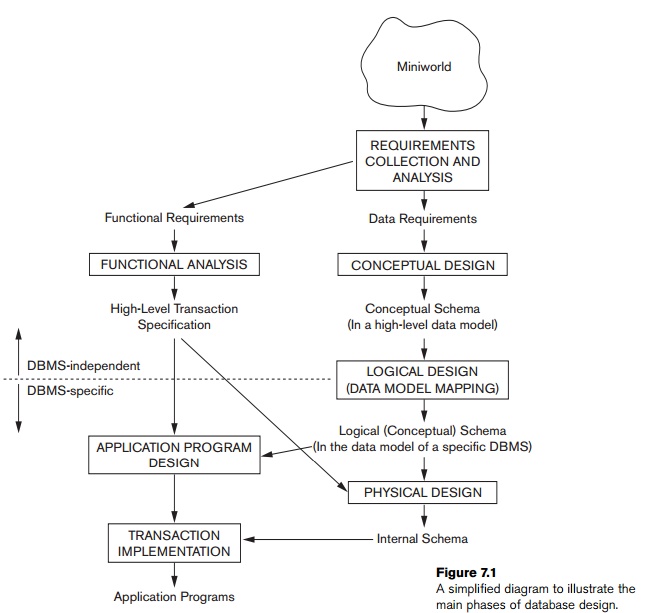High Level Conceptual Data Models for Database Design
Author : Ramez Elmasri, Shamkant B. Navathe Posted On :25.03.2017 09:22 pm
Figure 7.1 shows a simplified overview of the database design process.
Using High-Level Conceptual Data Models for Database Design Figure 7.1 shows a simplified overview of the database design process. The first step shown is requirements collection and analysis. During this step, the database designers interview prospective database users to understand and document their data requirements. The result of this step is a concisely written set of users' requirements. These requirements should be specified in as detailed and complete a form as possible. In parallel with specifying the data requirements, it is useful to specify the known functional requirements of the application. These consist of the user-defined operations (or transactions) that will be applied to the database, including both retrievals and updates. In software design, it is common to use data flow diagrams, sequence diagrams, scenarios, and other techniques to specify functional requirements. We will not discuss any of these techniques here; they are usually described in detail in software engineering texts. We give an overview of some of these techniques in Chapter 10. Once the requirements have been collected and analyzed, the next step is to create a conceptual schema for the database, using a high-level conceptual data model. This step is called conceptual design. The conceptual schema is a concise description of the data requirements of the users and includes detailed descriptions of the entity types, relationships, and constraints; these are expressed using the concepts provided by the high-level data model. Because these concepts do not include implementation details, they are usually easier to understand and can be used to communicate with nontechnical users. The high-level conceptual schema can also be used as a reference to ensure that all users' data requirements are met and that the requirements do not conflict. This approach enables database designers to concentrate on specifying the properties of the data, without being concerned with storage and implementation details. This makes it is easier to create a good conceptual data-base design. During or after the conceptual schema design, the basic data model operations can be used to specify the high-level user queries and operations identified during functional analysis. This also serves to confirm that the conceptual schema meets all the identified functional requirements. Modifications to the conceptual schema can be introduced if some functional requirements cannot be specified using the initial schema. The next step in database design is the actual implementation of the database, using a commercial DBMS. Most current commercial DBMSs use an implementation data model—such as the relational or the object-relational database model—so the conceptual schema is transformed from the high-level data model into the implementation data model. This step is called logical design or data model mapping; its result is a database schema in the implementation data model of the DBMS. Data model mapping is often automated or semiautomated within the database design tools. The last step is the physical design phase, during which the internal storage structures, file organizations, indexes, access paths, and physical design parameters for the database files are specified. In parallel with these activities, application programs are designed and implemented as database transactions corresponding to the high-level transaction specifications. We discuss the database design process in more detail in Chapter 10. We present only the basic ER model concepts for conceptual schema design in this chapter. Additional modeling concepts are discussed in Chapter 8, when we introduce the EER model.
Study Material, Lecturing Notes, Assignment, Reference, Wiki description explanation, brief detail
Fundamentals of Database Systems - Conceptual Modeling and Database Design - Data Modeling Using the Entity-Relationship (ER) Model : Using High-Level Conceptual Data Models for Database Design |
High Level Conceptual Data Models for Database Design
Source: https://www.brainkart.com/article/Using-High-Level-Conceptual-Data-Models-for-Database-Design_11428/
0 Response to "High Level Conceptual Data Models for Database Design"
Post a Comment